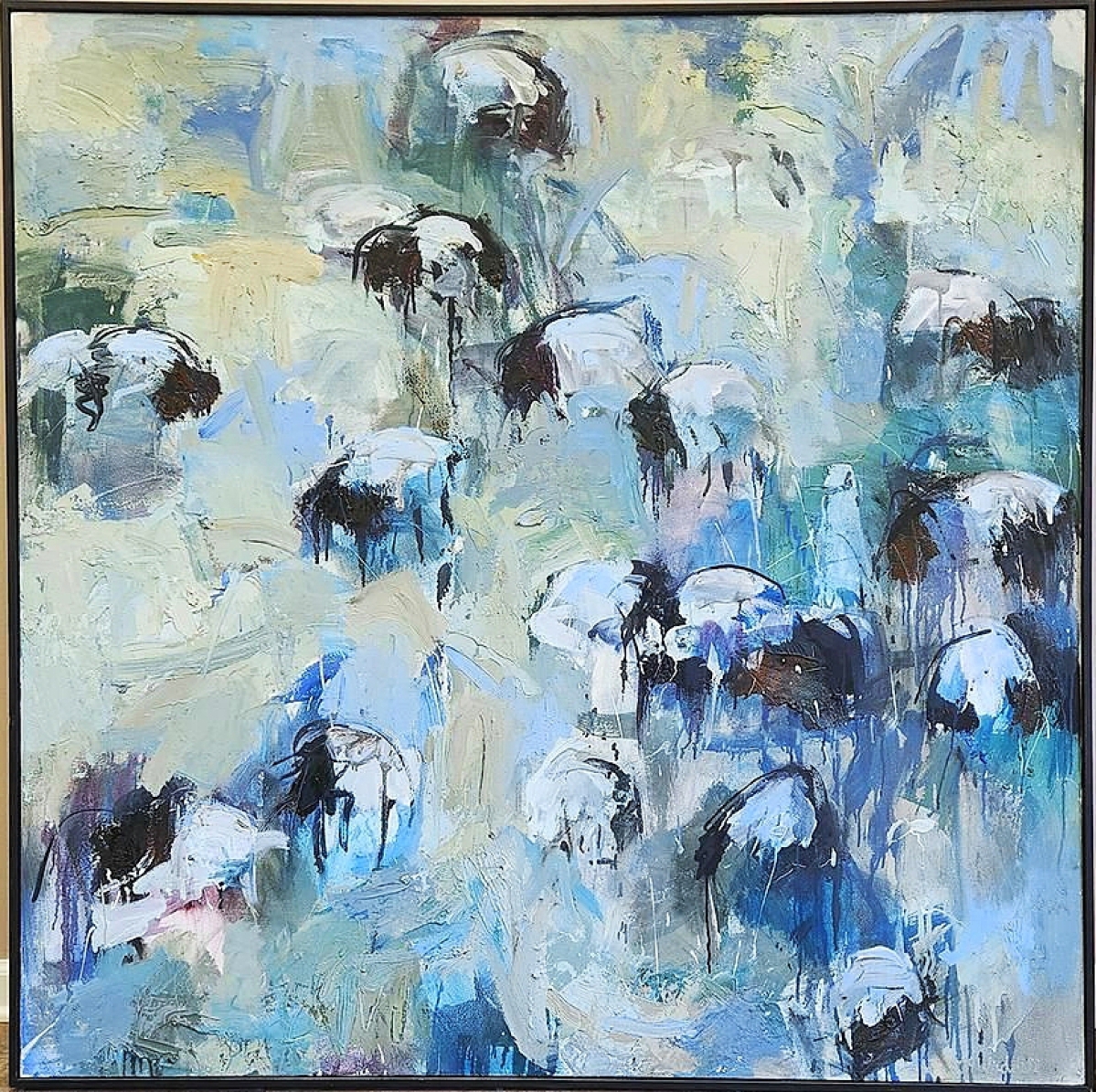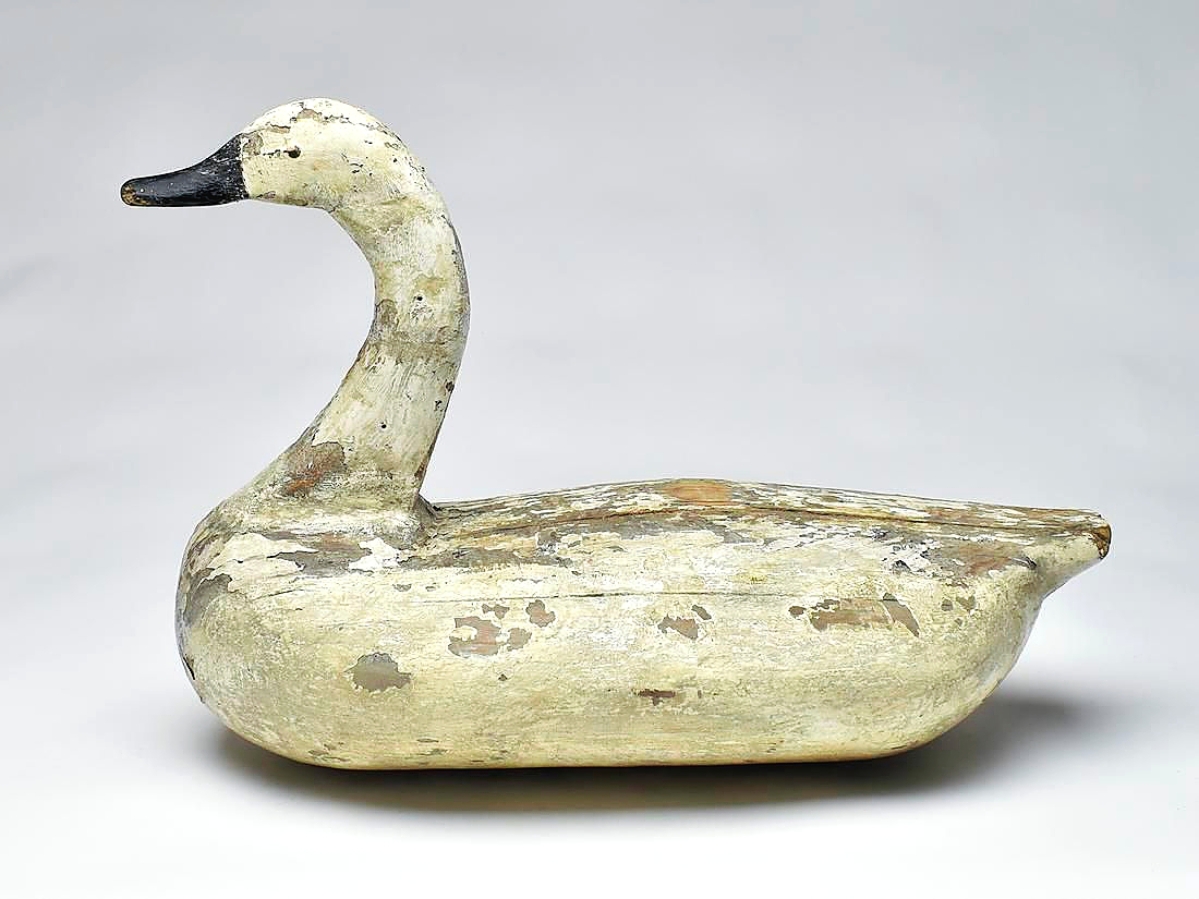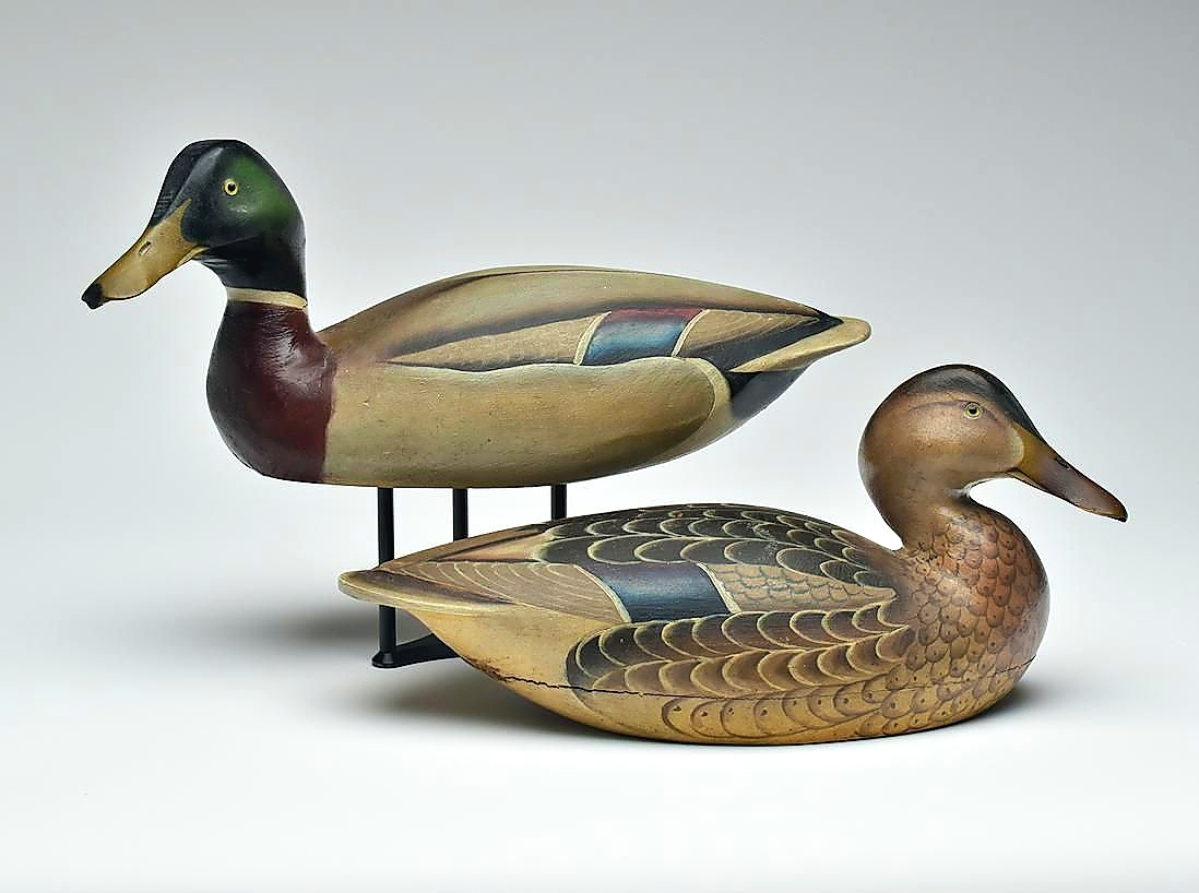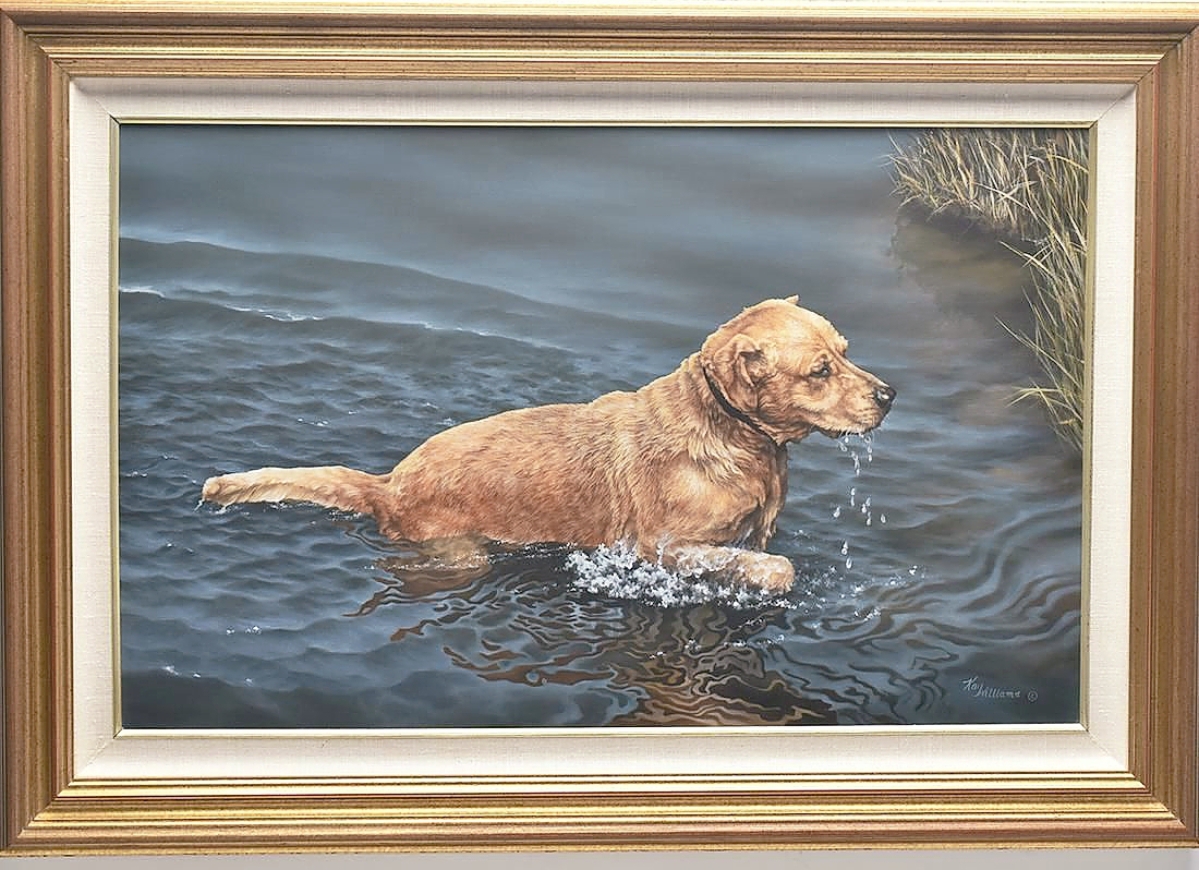
A pair of curlews made by Charles Coffin of Nantucket brought the highest price of the sale, $81,000. They were large, two-piece decoys. A second pair sold for $45,000.
Review By Rick Russack, Photos Courtesy Guyette & Deeter
EASTON, MD. – Even without any six-figure decoys, Guyette and Deeter’s November 9-10 auction grossed more than $2.5 million. The sale included a slightly different mix of offerings. Working decoys from various regions were among the top sellers, with examples from New England and Virginia doing well. There was a strong selection of decorative carvings by Frank Finney, Mark McNair, William Gibian and the Ward Brothers, among others. There was an unusually large offering of duck and turkey calls and four cigar store Indians from the Mark Goldman collection. Sporting art included works by Osthaus, Ripley and others. The printed catalog for this sale, more than 300 pages, included biographical information on several carvers that was not online, as well as some photographs that were not online.
Before the sale, Jon Deeter said that the market interest in decoys and contemporary carvings continues to grow. “Our weekly online sales give us a good barometer of what’s happening in the marketplace,” he said. “In order for new customers to bid, we ask for credit card numbers. So we can tell when someone is new to us, and most of those new people are bidding and many are winning. Our descriptions include a condition statement and our regular guarantee applies so first-time bidders can feel comfortable. This sale doesn’t have six-figure birds and that’s okay since most people aren’t buying six-figure birds. The sale has a strong selection of regional decoys with good examples of most of the well-known carvers, along with a very good selection of miniatures and decorative carvings, which are really hot right now.”
A pair of curlews carved on Nantucket by Charles Coffin in the third quarter of the Nineteenth Century led the sale, finishing at $81,000. A second pair by the same maker, from the same collection, sold for $45,000. After the sale, Deeter was asked about the difference in price. “We’re talking about sophisticated nuances. One pair had doweled heads and one pair had nailed heads. One pair had squared tails and one pair had pointed tails. Collectors notice those things. The four birds had been displayed together on a custom-made driftwood stand by the consignor. We thought about selling them as a group of four. When we x-rayed them and saw the construction difference, we decided to sell them as two pairs.” Other Nantucket decoys included a golden plover by a member of the Folger family. Selling for $33,000, it had carved wing outlines, glass eyes and a split, dropped tail. The printed catalog has an extensive discussion of Nantucket curlews.

Lem Ward, one of the Ward Brothers, was also a painter. Eight of his paintings were included in this sale. A 1948 oil on board of five pintails coming in for a landing realized $2,820.
It wouldn’t be a decoy auction without works by Elmer Crowell. There were more than 30 in this sale, with the most popular being a well-carved golden plover that sold for $21,000. His working decoys included an oversized pair of mallards that sold for $3,000 and a redhead with large glass eyes and a slightly turned head, which sold for $3,900. It also wouldn’t be a decoy auction without factory-made birds by The Mason Decoy Factory of Detroit, Mich. A standard grade rigmate pair of widgeons with original paint and minor gunning wear earned $13,200. A hollow carved, premier grade bluewing teal hen earned $4,800, and one of the firm’s shore birds, a willet with original paint, earned $4,500. Works by Crowell and Mason comprise two of the largest collecting categories. Works by Charles Walker, Robert Elliston, George Warren, Bert Graves and others were offered. Shore birds included examples by Obediah Verity, William Bowman and more.
The large selection of decorative carvings did well, including more than 30 works by Frank Finney, a Virginia carver born in 1947 who started carving at the age of 13. The list of well-known people who collect his carvings included Jackie Kennedy and Hollywood personalities such as Nicole Kidman. The star of the Finney carvings was a recently made 19-inch-tall bird tree with 21 different carved and painted song birds, all with glass eyes. It sold for $32,400. Discussing this carving with Finney a few days before the sale, he said, “This is the best one I’ve ever made. It has more birds than any other and it has a stand that I carved. The others I’ve done don’t have that.” A very unusual Finney carving, a standing Santa Claus, included wrapped gift boxes, miniature decoys by Ira Hudson, miniature shorebirds by William Bowman, a shotgun, a dog and more. It was done about 30 years ago and sold for $27,600.
Before the sale, Jon Deeter said, “I think Frank is one of the best of the contemporary folk-art carvers. That’s always been his niche. We’re good friends. I own some of his work, and my wife and I have given some of his carvings as wedding gifts. I’m glad to see him getting the recognition he deserves.”

The four Coffin curlews, as they were displayed by the consignor and pictured in the catalog. Collectively, the two pair earned $126,000.
Decorative carvings also included about a dozen by Mark McNair, another Virginia carver. Most popular with bidders at this sale was a pair of his miniature curlews. Signed and dated 2015, with relief carved wings, split tail and carved eyes, they sold for $2,040. His sons, Colin and Ian, also carve.
The Ward brothers, Lem (1896-1984) and Steve (1895-1976), from Crisfield, Md., are considered by many to have produced some of the finest decoys made in the Chesapeake Bay area, including working decoys as well as decorative carvings. One of the most eye-catching decorative carvings in the sale was their life-size bald eagle, 27 inches tall, standing on a branch, which sold for $48,000. It had deep relief wing and tail feather carving, was signed and dated ’67-’68, and was being sold at auction for the first time. A letter from the Ward Brothers accompanying the carving stated that it was the only eagle they had made.
Both brothers were barbers by trade and avid outdoorsmen. Steve carved his first decoy in 1907, and their early decoys were made for their own use. They sold their first decoy during World War I. Through the 1950s nearly all their carvings were meant to be working decoys. From the 1960s on, most of their work was decorative. The two-page biography of the Ward Brothers in the catalog includes a set of 16 photos picturing the many variations in the brothers’ work. One of the heavily promoted items in the sale was a rigmate pair of mallards, of which only three are known, and it topped the offerings of their work finishing at $60,000. Lem Ward was also a painter and this sale included eight of his paintings. They were landscapes, and the waterfowl he knew so well. The paintings do not bring the prices that their decoys and decorative carvings do. The highest price at this sale was for a 1948 oil on board of five pintails coming in for a landing, which realized $2,820.
As mentioned earlier, the sale included four cigar store Indians, all from the large Mark Goldman collection. One generally thinks of these figures as being of carved wood, but they were also cast in zinc, and it was a restored zinc example that brought the highest price, $60,000. The original mold was carved by Samuel Robb and cast by A. Selig at the William Demuth Company of New York. When made around 1880, it was known as “The Indian Hunter.” Most of these zinc figures fell victim to scrap metal drives during World War II. A carved wooden chief by Thomas Brooks, circa 1875, was holding a bundle of cigars and a cube of “cut plug” chewing tobacco. Also professionally restored, it earned $54,000. Goldman has been collecting since 1967 and owns more than 100 figures. Guyette and Deeter sold three from the Goldman collection in its last auction, and more will follow.

Shown in this vintage photo, the Ward brothers discuss one of their decoys.
Duck and turkey calls have an enthusiastic collector following. Some are vintage, and some are the work of contemporary carvers. There were more than 50 lots in this sale. James T. Beckhart, Big Lake, Ark., was one of the most prolific and talented producers of duck calls. He was also a guide and market gunner and, according to the catalog, in the 1890s, when the average wage was $1 a day, he was selling duck calls for $5. One of his calls brought $14,400, the highest price of the category. Some well-known decoy carvers also made duck calls. An example by Charles Perdew, Henry, Ill., sold for $8,400. A lot with three turkey calls made by Neil Cost, Greensboro, S.C., included two earlier calls, one dated 1970, another 1976 and a 1998 example. They brought $2,520.
Discussing the sale with John Deeter a few days after it ended, he commented on the diversity of the offerings and the interest in differing parts of the marketplace. “We had a larger selection of contemporary carvings than we usually do. I’m glad to see that. These carvings attract a younger audience, one reason being that the carvers display their recent works online and at the various wildlife festivals. Buyers can meet the carvers and learn about the men and the carvings. It’s also a good entry point – numerous collectors who first started with contemporary carvings, also get interested in the older, working decoys. We also had a large selection of calls. Those buyers are very knowledgeable and appreciate the nuances of the work. I was also glad to see the interest in works by some of the sporting artists that we don’t see as often, as well as the works by some of the major artists. We’re all pleased with the $2.5 million gross for the sale, and we’re excited about our upcoming sale of sporting firearms in February, and we have some really exciting folk art and fine art coming up.”
Prices given include the buyer’s premium as stated by the auction house. For information, www.guyetteanddeeter.com or 440-610-1768.




































